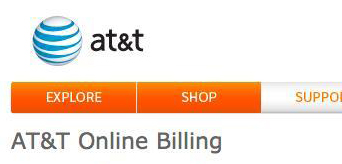|
|
Continue reading ETI Views and News at
econtech.com,
or download a
printer-friendly version.

Follow us on Twitter @EconAndTech
|
|
AT&T mulls third-party billing for data
|
|
 Just as – or perhaps because – the proliferation of mobile apps has expanded to the point where wireless carrier networks are experiencing demand levels that stretch their available capacity, the carriers are withdrawing their unlimited data plans and replacing them with relatively low "usage caps" above which often substantial "overage charges" will be imposed (see Views and News, February 2012). Most consumer-oriented wireline Internet access services in the US offer unlimited usage for a flat monthly charge or, if a usage cap is imposed, it is set at a level sufficiently high that only a minuscule fraction of consumers would ever exceed it. Consumers have thus come to view their use of the Internet as "free" in that their total monthly payment is unaffected by the volume of usage they make of the Internet access service.
Just as – or perhaps because – the proliferation of mobile apps has expanded to the point where wireless carrier networks are experiencing demand levels that stretch their available capacity, the carriers are withdrawing their unlimited data plans and replacing them with relatively low "usage caps" above which often substantial "overage charges" will be imposed (see Views and News, February 2012). Most consumer-oriented wireline Internet access services in the US offer unlimited usage for a flat monthly charge or, if a usage cap is imposed, it is set at a level sufficiently high that only a minuscule fraction of consumers would ever exceed it. Consumers have thus come to view their use of the Internet as "free" in that their total monthly payment is unaffected by the volume of usage they make of the Internet access service.
The potential of some sort of pay-as-you-go Internet access pricing confronts consumers with the prospect of having to pay their wireless carrier for their use of specific websites or apps, a condition that could well chill consumer demand for such services. From the standpoint of e-commerce providers or other websites that generate revenue from user access to their services, the practice of metering and charging based upon bits sent and received could undermine their business models and cost them revenues and profits.
In the circuit-switched telephone service world, consumers were often subject to substantial usage-based charges, particularly for "toll" or "long distance" calls, and providers of goods and services that transacted business over the telephone would have had great difficulty convincing their prospective customers to pay toll charges in order to reach them. Early on, some companies would advertise their willingness to accept "collect calls" from customers; because some customers might have been reluctant even to attempt to place such collect calls (which required that the customer provide his or her name to the long distance operator), AT&T created a reverse charge service known as "Enterprise Calling" in which the call recipient would be assigned an "Enterprise" number (e.g., "Enterprise 2345") which would be translated into the recipient's phone number with the call completed by the AT&T operator on a reverse-charge basis. The eventual solution was a mechanized reverse-charge calling service. Calls were placed using a special "toll-free" phone number (initially using the '800' service access code), which was translated by the public switched telephone network into a routing to the call recipient. The charge for the call was billed to the call recipient under one of several "800 Service" pricing plans.
Now, AT&T has surfaced the idea of an 800-type charging scheme for wireless data usage. John Donovan, AT&T's Senior Executive Vice President for Technology and Network Operations, announced a possible new approach to billing for data services: charge the website owner or app maker for the data used when AT&T subscribers visit specific sites or use specific apps. Such use would not count against consumers' monthly data allotment. Consumers would effectively gain more "free" data use, while AT&T gains a new way to monetize its data product and boost revenues.
Providers of mobile services are currently beneficiaries of mobile data plans. Industry profits on apps and web offerings have soared recently along with use of cellular data services; and growth in usage is not expected to subside any time soon. However, as usage skyrockets, and as carriers have eliminated unlimited data plan offerings in favor of capped usage with high overage charges, these third parties may find it profitable – perhaps even essential – that they agree to cover the cost of the data used by consumers of their services in order to encourage and grow such usage.
The details of how AT&T would structure such deals are far from clear. AT&T hopes to roll out the new plan sometime next year, and the concept is only being discussed presently at a very high level.
A boon for consumers, or a blow to net neutrality?
But is creating an 800-type charging scheme for wireless data access all that AT&T is up to? Not very likely. We discussed the need for carriers to find innovative ways to boost data revenues to cover the costs of subsidizing expensive smartphones last month (Views and News, February 2012). Getting app makers to subsidize the underlying data service would certainly represent a new revenue stream for wireless carriers. But is it innovative? Billing third parties for access to its customers has been in the back of AT&T's mind for some time now. Former AT&T CEO Ed Whitacre famously quipped of internet companies:
"How do you think they're going to get to customers? Through a broadband pipe. Cable companies have them. We have them. Now what they would like to do is use my pipes free, but I ain't going to let them do that because we have spent this capital and we have to have a return on it. So there's going to have to be some mechanism for these people who use these pipes to pay for the portion they're using. Why should they be allowed to use my pipes?"
AT&T's Donovan innocuously likens the scheme to 800 telephone service, where the recipient, rather than the person placing the call, picks up the tab. But when AT&T introduced toll-free long distance calling back in the late 1960s, its rates were regulated by the FCC and in many cases 800 Service – which was offered under a bulk usage pricing arrangement – was actually cheaper than by-the-call outbound long distance rates. But if it is still AT&T's position that it "ain't gonna let them [i.e., commercial websites and app developers] use AT&T's pipes free," then this seemingly innovative pricing option may in the end drive the entirety of wireless data pricing. Upon closer examination, AT&T's plan actually represents yet another blow to net neutrality in that, among other things, it would permit AT&T to establish content- or application-based pricing, charging the service provider different prices based upon the nature of the use being made of its wireless data services.
AT&T could, for example, impose a higher price per kb transmitted for applications requiring packet prioritization or low latency, such as VoIP, video conferencing (e.g., Skype, Apple's Facetime, Google's video chat), and Netflix-type streaming videos. While it might be argued that the requirement for priority treatment imposes greater demand on AT&T's IP network than for the less-immediate transmission requirements of applications such as e-mail, online banking and shopping, and text or still image downloads, there is neither a market-based nor a regulatory mechanism for ensuring that any pricing differentials accurately reflect and capture such cost differences as may actually exist.
In the heated discussions that led up to the FCC's December 2010 Net Neutrality rulings, proponents of net neutrality insisted that an Internet access provider's ability to offer "paid prioritization," where carriers would apply surcharges or other pricing differentiation for prioritizing network traffic, would undermine the goal of an open and neutral Internet. And in its 2010 Net Neutrality Order, the FCC generally prohibits such pricing discrimination – but only for fixed wireline Internet service providers. Such restrictions generally do not apply for wireless carriers, and so the reverse-charge idea being floated now by AT&T appears to be a back-door way of accomplishing the paid prioritization that the carrier has been seeking for some time.
How is this different from free or subsidized Wi-Fi?
Many brick-and-mortar businesses offer their customers free Internet access via Wi-Fi, and some paid Wi-Fi services occasionally offer promotions where the cost of the Wi-Fi is borne by a subsidizing advertiser, rather than by the end user. For example, users of San Francisco International Airport (SFO) access free Wi-Fi sponsored by American Express. Google subsidized in-flight Wi-Fi on several airlines as part of a promotion for its Chrome web browser and Chromebook computers. Amtrak provides free Wi-Fi at some of its stations and trains. These sponsorships differ from AT&T's proposed reverse-charge plan in that these Wi-Fi services provide access to the full Internet, not just to a selection of websites and apps selected by the sponsor. Users of the Google promotion could use an Apple laptop, search the web with Microsoft Bing, and check their Yahoo email account. AT&T sells unfettered Internet access to its consumers, but its proposed targeted promotions would limit the uses of the subsidized service. While consumers could spend more money to visit other sites, non-subsidized traffic would face a serious artificial competitive hurdle, one that could ultimately force the sponsors of those sites and apps to fork over whatever tribute AT&T may demand.
The inherent limitations on wireless spectrum, cell-splitting and other realities of wireless data networks make it highly unlikely that we will see a return to unlimited use pricing anytime soon. And in the pay-as-you-go pricing world, some type of toll-free or reverse-charge billing may be an important business tool to foster continued growth. So long as network neutrality considerations are met, the idea should not be dismissed out of hand merely because of the dangers it also portends.
For more information, contact Colin B. Weir at cweir@econtech.com
Read the rest of Views and News, March 2012.
|
|
|
|
About ETI. Founded in 1972, Economics and Technology, Inc. is a leading research and consulting firm specializing in telecommunications regulation and policy, litigation support, taxation, service procurement, and negotiation. ETI serves a wide range of telecom industry stakeholders in the US and abroad, including telecommunications carriers, attorneys and their clients, consumer advocates, state and local governments, regulatory agencies, and large corporate, institutional and government purchasers of telecom services. |
|
|